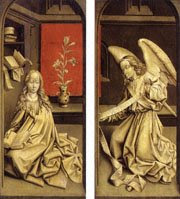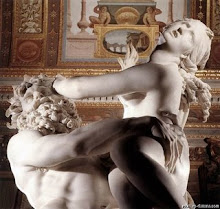skip to main |
skip to sidebar





 VERKOLJE, Johannes
VERKOLJE, Johannes
(b. 1650, Amsterdam, d. 1693, Delft)
Biography
Dutch painter, member of a family of painters. He was the son of a locksmith, specialized in genre scenes set in richly furnished interiors, although he also painted mythological scenes and portraits. His two sons, Nicolaas Verkolje and Johannes Verkolje II (d 1760) were also painters and his followers.
According to Houbraken, he spent six months as the pupil of Jan Andrea Lievens (1644-80), where he completed unfinished mythological and genre pictures by Gerrit Pietersz. van Zijl (1619-65). Verkolje married Judith Voorheul in Delft in 1672 and in the following year joined the city's Guild of St Luke, serving as its dean between 1678 and 1688.
Verkolje's genre scenes, for example the Musical Company (1673; Amsterdam, Rijksmuseum), The Messenger (1674; The Hague, Mauritshuis) and the Elegant Couple (c. 1674; private collection), were influenced by Gabriel Metsu, Gerard Terborch and Caspar Netscher. Verkolje's portraits commanded high prices and were greatly valued for their outstanding finish, a style more polished than that of his predecessors. His work as a mezzotint engraver was equally appreciated and sought after. On the basis of a few mezzotints made between 1680 and 1684 after the work of English artists, it is generally supposed that Verkolje lived in London at that time, although this is unproven.
As a draughtsman, he made precise, small cabinet pieces usually employing pen and ink with brown wash or watercolour heightened with white chalk. Houbraken mentioned Albertus van der Burgh (b 1672), Joan van der Spriet (fl c. 1700) and Willem Verschuuring (1657-1715), among others, as Verkolje's pupils.
VERKOLJE, Johannes
(b. 1650, Amsterdam, d. 1693, Delft)
Biography
Dutch painter, member of a family of painters. He was the son of a locksmith, specialized in genre scenes set in richly furnished interiors, although he also painted mythological scenes and portraits. His two sons, Nicolaas Verkolje and Johannes Verkolje II (d 1760) were also painters and his followers.
According to Houbraken, he spent six months as the pupil of Jan Andrea Lievens (1644-80), where he completed unfinished mythological and genre pictures by Gerrit Pietersz. van Zijl (1619-65). Verkolje married Judith Voorheul in Delft in 1672 and in the following year joined the city's Guild of St Luke, serving as its dean between 1678 and 1688.
Verkolje's genre scenes, for example the Musical Company (1673; Amsterdam, Rijksmuseum), The Messenger (1674; The Hague, Mauritshuis) and the Elegant Couple (c. 1674; private collection), were influenced by Gabriel Metsu, Gerard Terborch and Caspar Netscher. Verkolje's portraits commanded high prices and were greatly valued for their outstanding finish, a style more polished than that of his predecessors. His work as a mezzotint engraver was equally appreciated and sought after. On the basis of a few mezzotints made between 1680 and 1684 after the work of English artists, it is generally supposed that Verkolje lived in London at that time, although this is unproven.
As a draughtsman, he made precise, small cabinet pieces usually employing pen and ink with brown wash or watercolour heightened with white chalk. Houbraken mentioned Albertus van der Burgh (b 1672), Joan van der Spriet (fl c. 1700) and Willem Verschuuring (1657-1715), among others, as Verkolje's pupils.

 VELDE, Willem van de, the Younger
VELDE, Willem van de, the Younger
(b. 1633, Leiden, d. 1707, London)
Biography
Velde, van de, family of Dutch marine painters and landscapists of the 17th century.
Willem van de Velde the Elder (circa 1611-93)
Dutch marine painter. He was the son of a naval captain, his brother was a skipper of merchant vessels, and he himself spent part of his youth as a sailor before devoting himself to the drawing and painting of ships. His pictures, which are frequently grisailles, contain faithful and detailed portraits of ships (of much value to naval historians) and for a time he was an official artist for the Dutch fleet. In 1672, when the Netherlands were at war with England, he went to London and entered the service of Charles II; why he left his country at a critical moment in its fortunes remains a mystery.
Willem van de Velde the Younger (1633-1707)
Willem's son, he is one of the most illustrious of all marine painters. He was the pupil of his father and Simon de Vlieger. Like his father, he gave very accurate portrayals of ships, but is distinguished from him by his feeling for atmosphere and majestic sense of composition. He left Amsterdam for England with his father in 1672 and in 1674 Charles II gave them a yearly retaining fee of 100 pounds each; the father received his "for taking and making draughts of seafights" and the son "for putting the said draughts into colours for our own particular use". They did not switch their allegiance to England completely; both subsequently painted pictures of naval battles for the Dutch as well as the English market. Willem the Younger's influence, however, was particularly great in England, where the whole tradition of marine painting stemmed from him.
Adriaen van de Velde (1636-72)
Brother of Willem the Younger, was a prolific artist in spite of his short life. His father and Jan Wijnants were his teachers. He painted various types of landscapes (most notably some fresh and atmospheric beach scenes) and also religious and mythological works, portraits, and animal pictures. He also did exceptionally fine etchings of landscapes with cattle and often painted the figures into the landscapes of other artists, notably Hobbema and Ruisdael.

NALDINI, Giovan Battista
(b. ca. 1537, Fiesole, d. 1591, Firenze)
Biography
Italian painter and draughtsman. He was the artistic heir of Jacopo Pontormo, with whom he trained from 1549 to 1556. While maintaining an allegiance to the ideals of Andrea del Sarto and Pontormo, he also worked in the vocabularies of Bronzino and Vasari. From these sources he forged an individual style of drawing indebted to del Sarto in its loose handling of chalk and reminiscent of Pontormo in its schematic figures defined by firm contours and modelled with loose hatching or spots of wash. There are an analogous stylization and an expressive freedom in his treatment of serpentine figures, which are sculptural in form but painterly in detail, arranged in compact compositions with concentrated lights revealing passages of warm yellows, reds and greens. Particularly characteristic is the Christ Carrying the Cross (1566; Florence, S Maria Assunta), which is distinguished in its colouring and expressive figures from the chill linearity and metallic forms of Bronzino, Vasari and Alessandro Allori.


 SUVÉE, Joseph-Benoit
SUVÉE, Joseph-Benoit
(b. 1743, Brugge, d. 1807, Roma)
Biography
Flemish painter from Bruges. He was always referred to by Jacques-Louis David as 'l'ignare Suvée', and was, like David, a pupil of Vien, and David's lifelong rival for the leadership of Neoclassicism in France. He came from Bruges to Paris and won the Prix de Rome against David in 1771, spending a year at the École des Élèves protégés, and then going to Rome 1772-78, after which he returned to Paris and became Agréé (1779) and Member of the Academy (1780) and Painter to the King. He returned to Rome as Director of the French Academy there, in 1792, but lost his job when David became dictator of the arts. He was imprisoned (like David) under the Terror. 1794-95, but was reappointed to Rome by Napoleon in 1801 and remained there until his death. His works are now largely forgotten, but there are several in Bruges and others in French provincial museums, including Besançon and Lille.


 AACHEN, Hans von
AACHEN, Hans von
(b. 1552, Köln, d. 1615, Praha)
Biography
German painter, born in Cologne (in spite of his name, which derives from his father's birthplace) and active in the Netherlands, Italy (1574-87), and most notably Prague, where he settled in 1596 as court painter to the emperor Rudolf II. On Rudolf's death (1612) he worked for the emperor Matthias.
His paintings, featuring elegant, elongated figures, are - like those of his colleague Bartholomeus Spranger - leading examples of the sophisticated Mannerist art then in vogue at the courts of Northern Europe, and he was particularly good with playfully erotic nudes (The Triumph of Truth, Alte Pinakothek, Munich, 1598). Engravings after his work gave his style wide infiuence and he ranks as one of the most important German artists of his time.
AACHEN, Hans von
(b. 1552, Köln, d. 1615, Praha)
Biography
German painter, born in Cologne (in spite of his name, which derives from his father's birthplace) and active in the Netherlands, Italy (1574-87), and most notably Prague, where he settled in 1596 as court painter to the emperor Rudolf II. On Rudolf's death (1612) he worked for the emperor Matthias.
His paintings, featuring elegant, elongated figures, are - like those of his colleague Bartholomeus Spranger - leading examples of the sophisticated Mannerist art then in vogue at the courts of Northern Europe, and he was particularly good with playfully erotic nudes (The Triumph of Truth, Alte Pinakothek, Munich, 1598). Engravings after his work gave his style wide infiuence and he ranks as one of the most important German artists of his time.





































.jpg)

.jpg)








